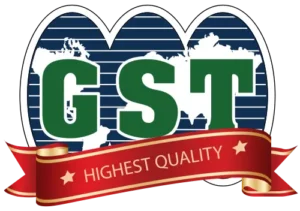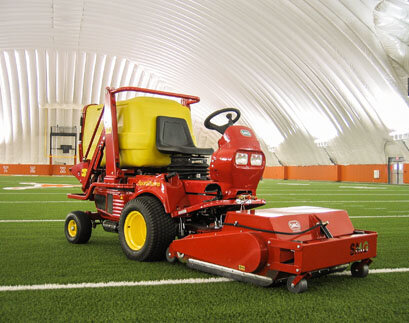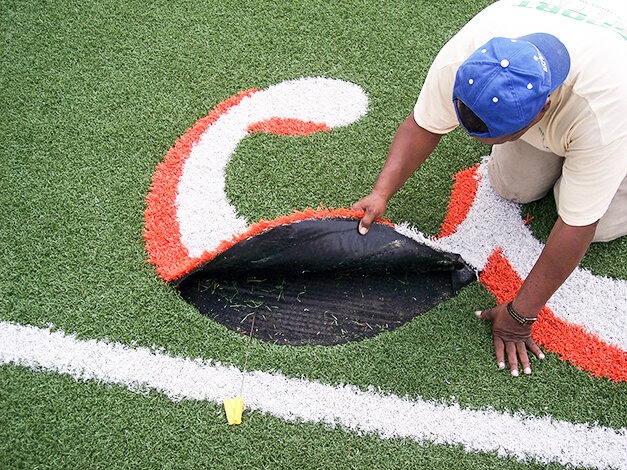Synthetic turf is also known as artificial turf, and sometimes “fake grass”. It’s a surface made from synthetic fibers that replicate the texture and appearance of natural grass. Because of its durability and has low-maintenance, artificial turf is often chosen for sports fields.
Artificial turf was introduced for the first time in 1960 as a football playing surface and has since been used in many sports field situations such as soccer, baseball and field hockey.
Technological advancements have allowed for the creation of synthetic grass that is almost indistinguishable to natural grass.
Synthetic turf’s ability to withstand heavy foot traffic and use is one of its main advantages, making it a popular choice on sports fields that are subject to regular play.
Artificial turf is more durable than natural grass and offers many other advantages, significantly, it requires less maintenance. This eliminates the need to mow, water, or fertilize. It drains faster, which means that even in adverse weather conditions, the playing surface stays dry and safe.
As it provides a stable and consistent playing surface for athletes, and it can withstand heavy use, artificial turf is an effective and popular alternative to natural grass in sports fields for schools, colleges and professional sports teams.
Low Maintenance: Synthetic turf requires much less maintenance than natural grass. There is no need for watering, mowing, or fertilizing. This can save a significant amount of time and money.
Durability: Synthetic turf is very durable and can withstand heavy use, making it ideal for sports fields. It can withstand harsh weather conditions, foot traffic, and intense play without getting damaged.
Consistent playing surface: Synthetic turf provides a consistent playing surface that is not affected by weather conditions like rain or drought. This helps to reduce the risk of injuries and enhances the overall playing experience.
Versatility: Synthetic turf can be installed in a variety of locations and settings, making it a versatile option for sports fields. It can be used for football, soccer, lacrosse, baseball, and many other sports.
Cost-effectiveness: Although the initial installation cost of synthetic turf may be higher than natural grass, over time, it can save money due to reduced maintenance costs, and a longer lifespan. It also eliminates the need for ongoing expenditures on fertilizers, pesticides, and water bills.
Overall, installing synthetic turf for a sports field can provide significant benefits for both players and facility owners.
Synthetic turf sports surfaces are installed in several steps. The following is a general overview of the process:
Site Preparation: The first step is to prepare the site where the synthetic turf will be installed. This involves removing any existing grass, vegetation, or debris and leveling the surface. The surface must be smooth and even to ensure proper drainage.
Base Construction: Next, a base is constructed using a mixture of crushed stone, sand, and/or gravel. This layer provides a stable foundation for the synthetic turf and helps with drainage.
Drainage Installation: Drainage is important for maintaining the quality of the playing surface. A perforated pipe is installed within the base layer, which is then covered with a layer of filter fabric to prevent the accumulation of dirt and debris.
Turf Installation: Once the base and drainage are in place, the synthetic turf can be installed. The turf is typically rolled out and secured to the base with adhesive or fasteners.
Infill Application: Infill is added to the surface of the turf to provide cushioning and support. Typically, a mixture of sand and rubber is used. The infill is spread over the surface of the turf and then brushed into the fibers to ensure even coverage.
Field Markings: Finally, the field markings are added to the synthetic turf. These include the lines for the playing field, boundaries, and any other required markings.
Overall, the installation of synthetic turf sports surfaces requires careful planning and execution to ensure a high-quality playing surface that is safe and durable.
Synthetic sports fields require regular maintenance to ensure optimal performance, safety, and longevity. Here are some of the key maintenance processes for synthetic sports field surfaces:
Regular cleaning: Regular cleaning is essential to keep the surface free of debris, dirt, and dust. A soft brush or broom should be used to sweep the surface regularly to remove any loose particles. In addition, a high-pressure hose can be used to remove more stubborn dirt or debris.
Grooming: Grooming is a process of restoring the pile height and leveling the infill material. This is typically done using a special machine called a grooming brush or drag brush. Grooming should be done at least once a month or more frequently, depending on the level of use.
Infills maintenance: The infill material, which is typically made of rubber or sand, can become compacted over time, leading to reduced shock absorption and increased risk of injury. Regular infill maintenance is therefore important to ensure the proper level of cushioning. This can be done by using a specialized machine that loosens and redistributes the infill material.
Repairs: Regular inspections should be carried out to identify any damage to the surface, such as tears or rips. These should be repaired promptly to prevent further damage and maintain the integrity of the surface.
Disinfection: Disinfecting the surface is important to prevent the growth of bacteria and other harmful microorganisms. This can be done using a specialized disinfectant spray that is safe for synthetic surfaces.
Seasonal maintenance: Depending on the climate and weather conditions, additional maintenance may be required seasonally. For example, during the winter, it may be necessary to remove snow and ice from the surface to prevent damage.
Overall, regular and thorough maintenance is essential to ensure that synthetic sports fields remain safe, durable, and provide optimal performance for athletes.

ASTRO Turf is as possibly as synonymous to artificial grass or turf as Hoover is to vacuum cleaners.
AstroTurf is the brand of artificial turf that was invented in 1964 by chemist James Faria and football coach Robert Wright.
The original AstroTurf was a short-pile synthetic turf that was first installed at the Houston Astrodome in 1966, replacing the natural grass that could not grow indoors.
It was quickly adopted by other sports teams and venues due to its durability, low maintenance, and consistent playing surface.
Over the years, AstroTurf has evolved with new technologies and materials, including longer and softer fibers, infill systems, and shock pads, making it a popular choice for not only sports but also landscaping and other applications.
XGrass is a synthetic turf company that was founded in 1997 by Jim and Dan Cobb.
The company began by selling and installing synthetic turf for athletic fields and has since expanded to offer products for a range of applications, including residential lawns, putting greens, playgrounds, and landscaping.
XGrass prides itself on using eco-friendly materials and sustainable manufacturing practices to produce their products. They have also developed proprietary technologies, such as XGrass Armor, which improves the durability and longevity of their turf.
Today, XGrass is a leading provider of synthetic turf solutions in the United States, serving both commercial and residential customers.

Global Syn-Turf is a company that specializes in the manufacturing and distribution of artificial grass for various applications, such as landscaping, sports fields, and pet areas.
The company was founded in 2009 and is headquartered in Dalton, Georgia, USA. Over the years, Global Syn-Turf has become a leading supplier of artificial grass products, offering a wide range of styles, colors, and textures to meet the needs of its customers.
The company has also expanded its operations globally, with distribution centers in several countries, including Canada, Australia, and Europe.
Today, Global Syn-Turf is recognized as one of the most reputable and innovative companies in the artificial turf industry.

Shaw Sports Turf is a division of the Shaw Industries Group, Inc., a global flooring provider.
The company entered the sports turf market in 2002 and quickly established itself as a leading manufacturer of synthetic turf systems.
In 2016, Shaw Sports Turf merged with Southwest Greens, a company specializing in the installation of synthetic putting greens, to expand their offerings to include golf course applications.
Today, Shaw Sports Turf continues to innovate and provide state-of-the-art synthetic turf systems for a variety of sports, including football, soccer, baseball, and rugby.
They have installations across the world, including major professional sports stadiums and collegiate athletic fields.



